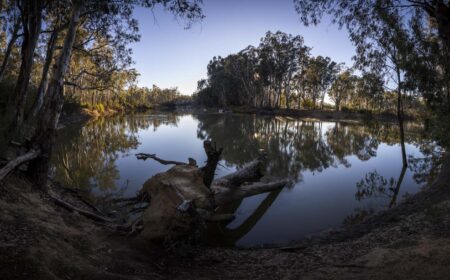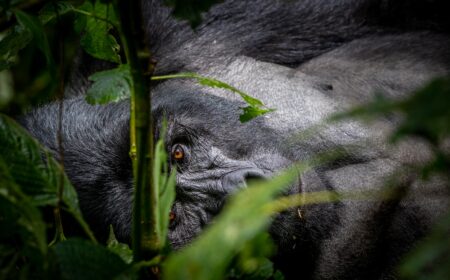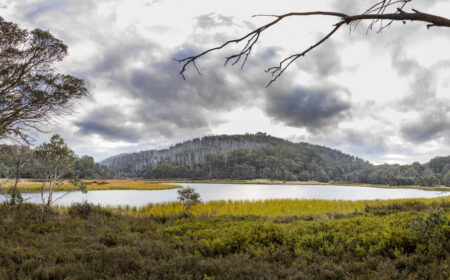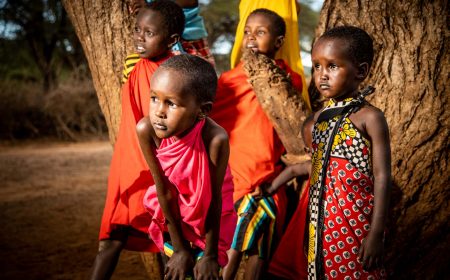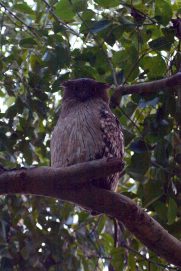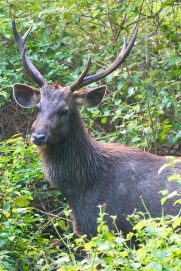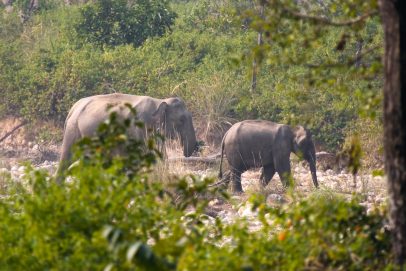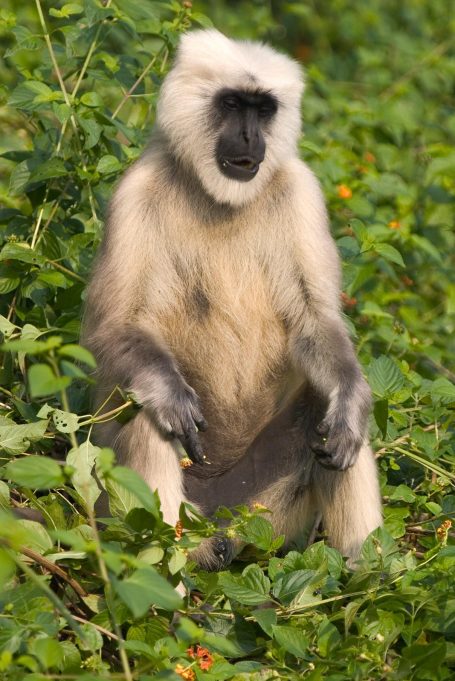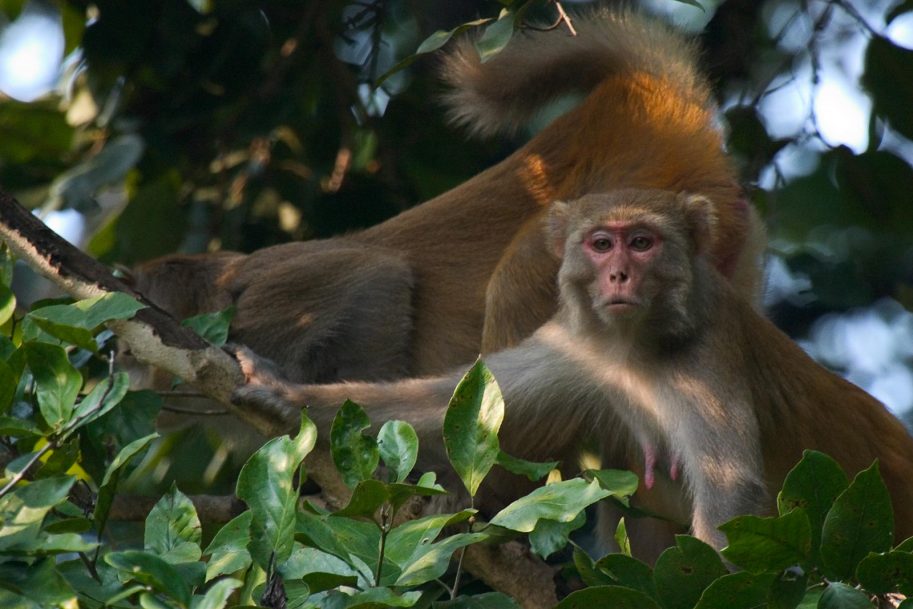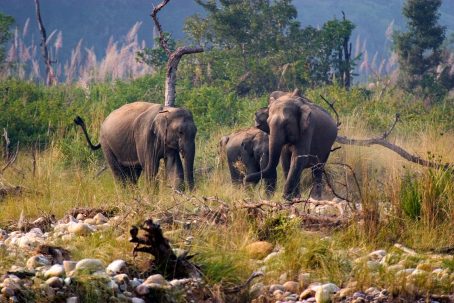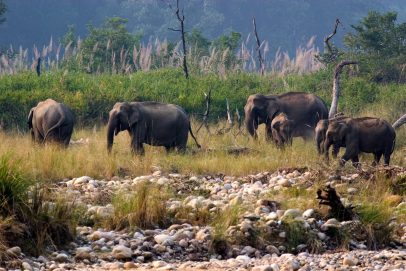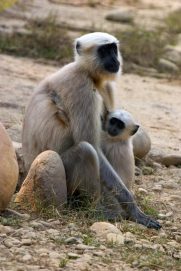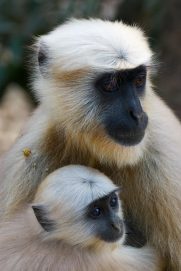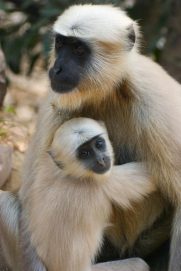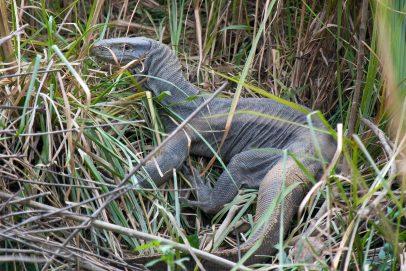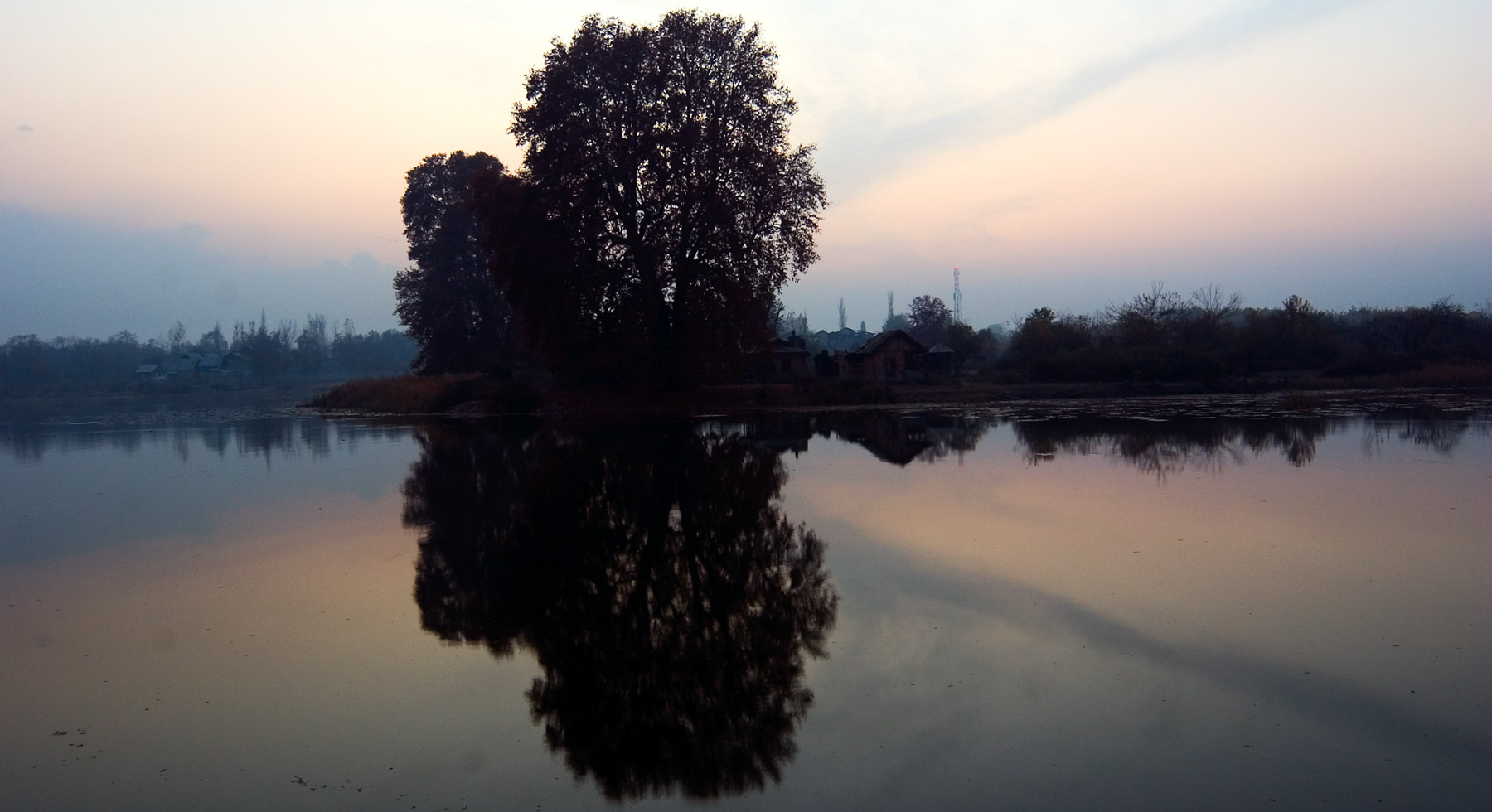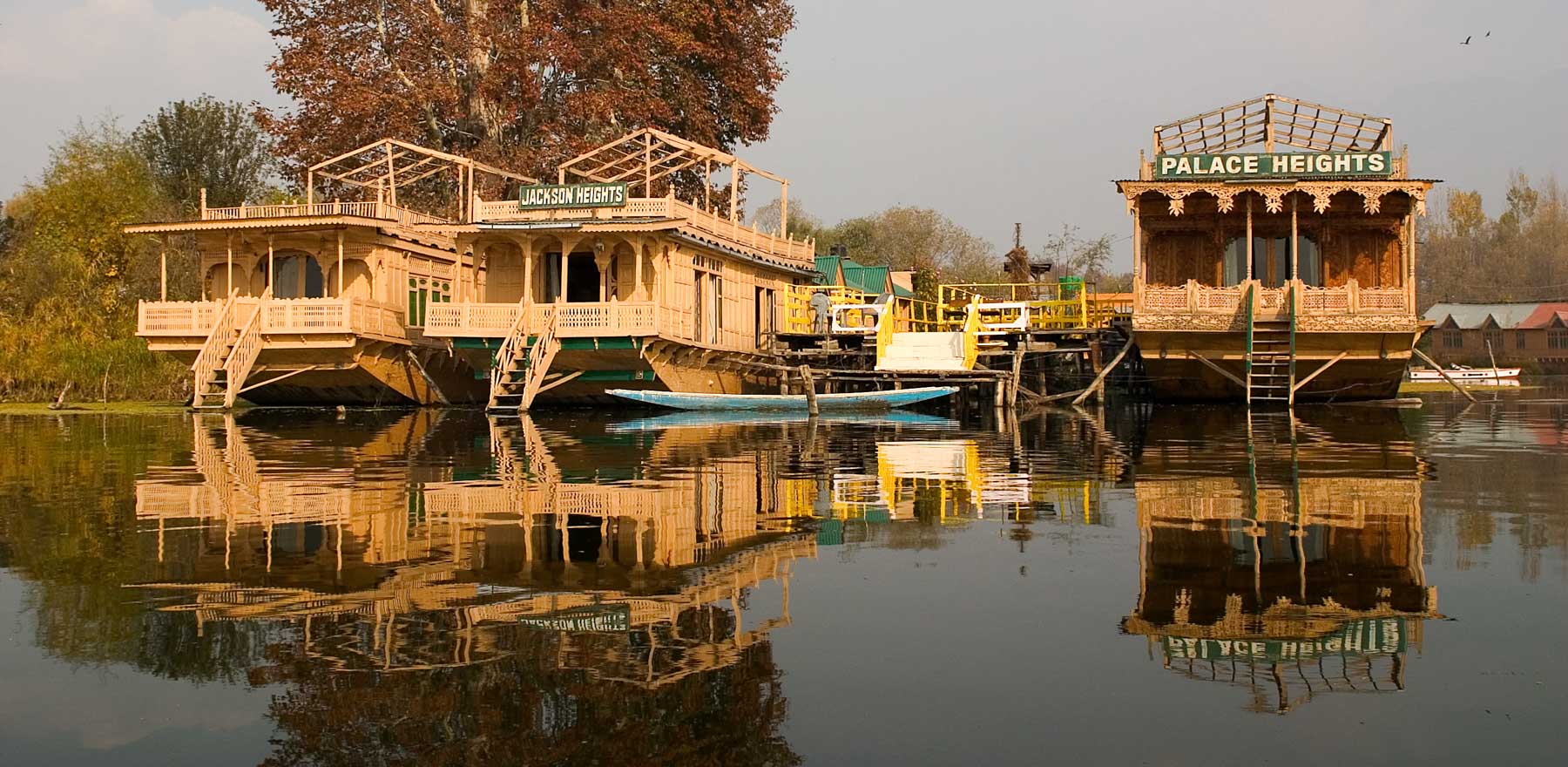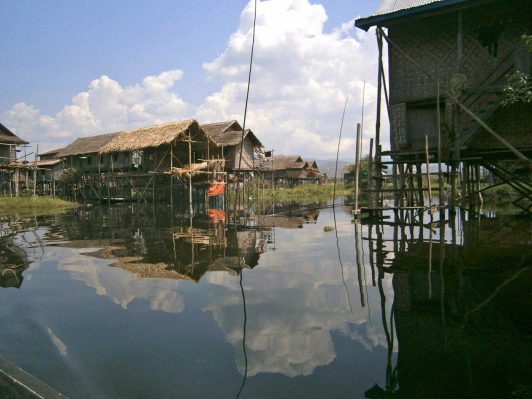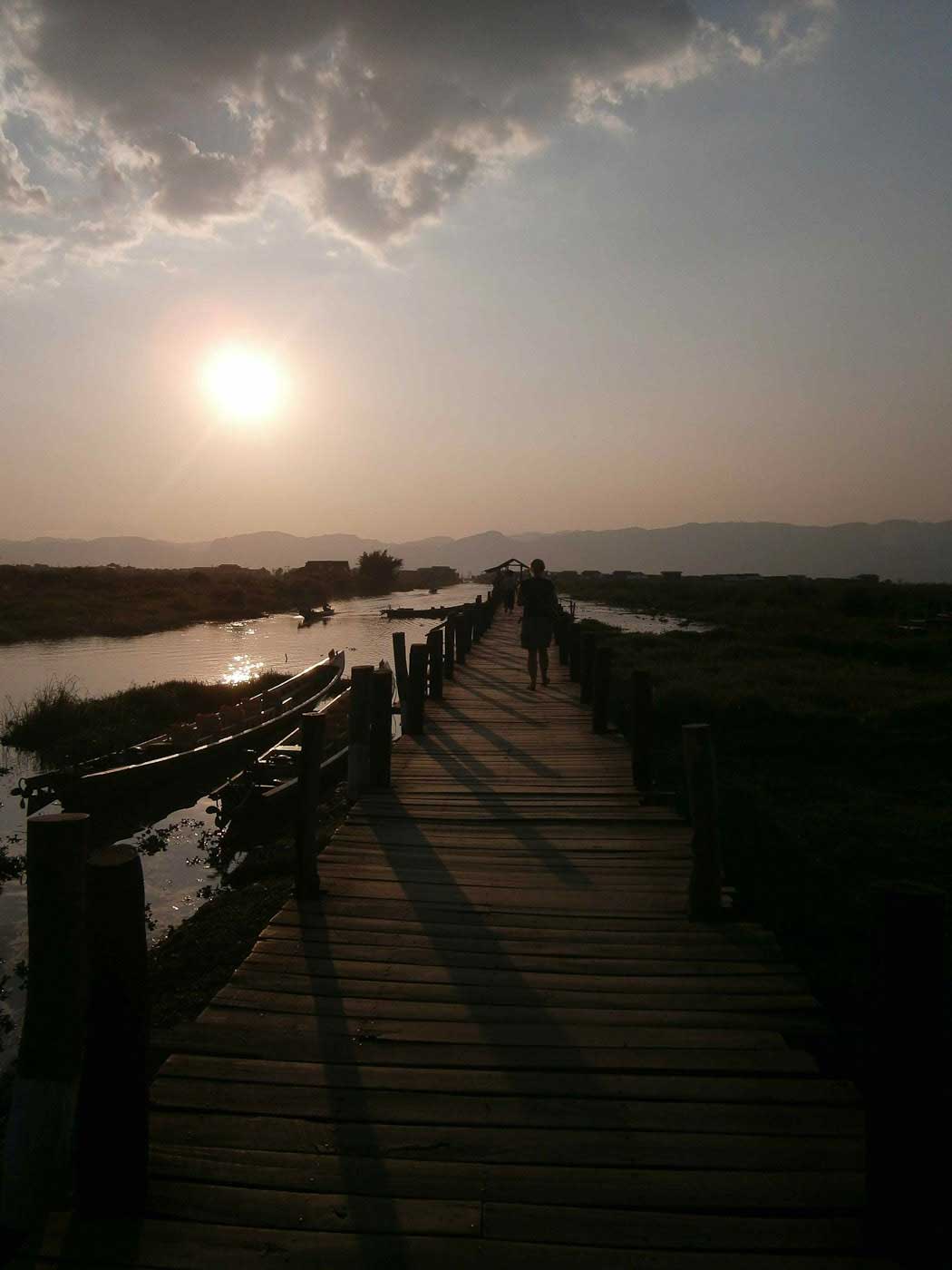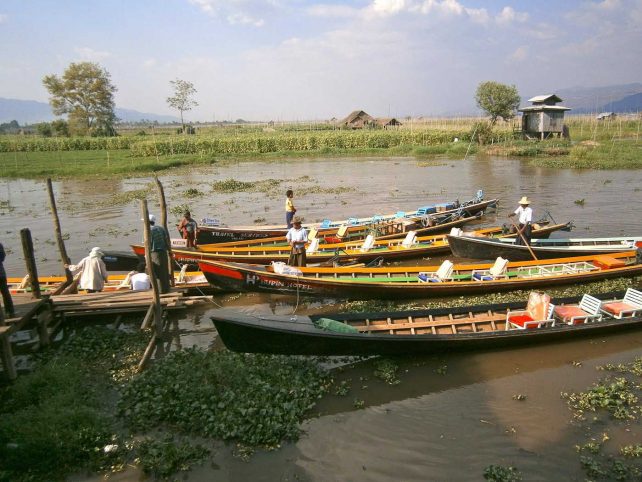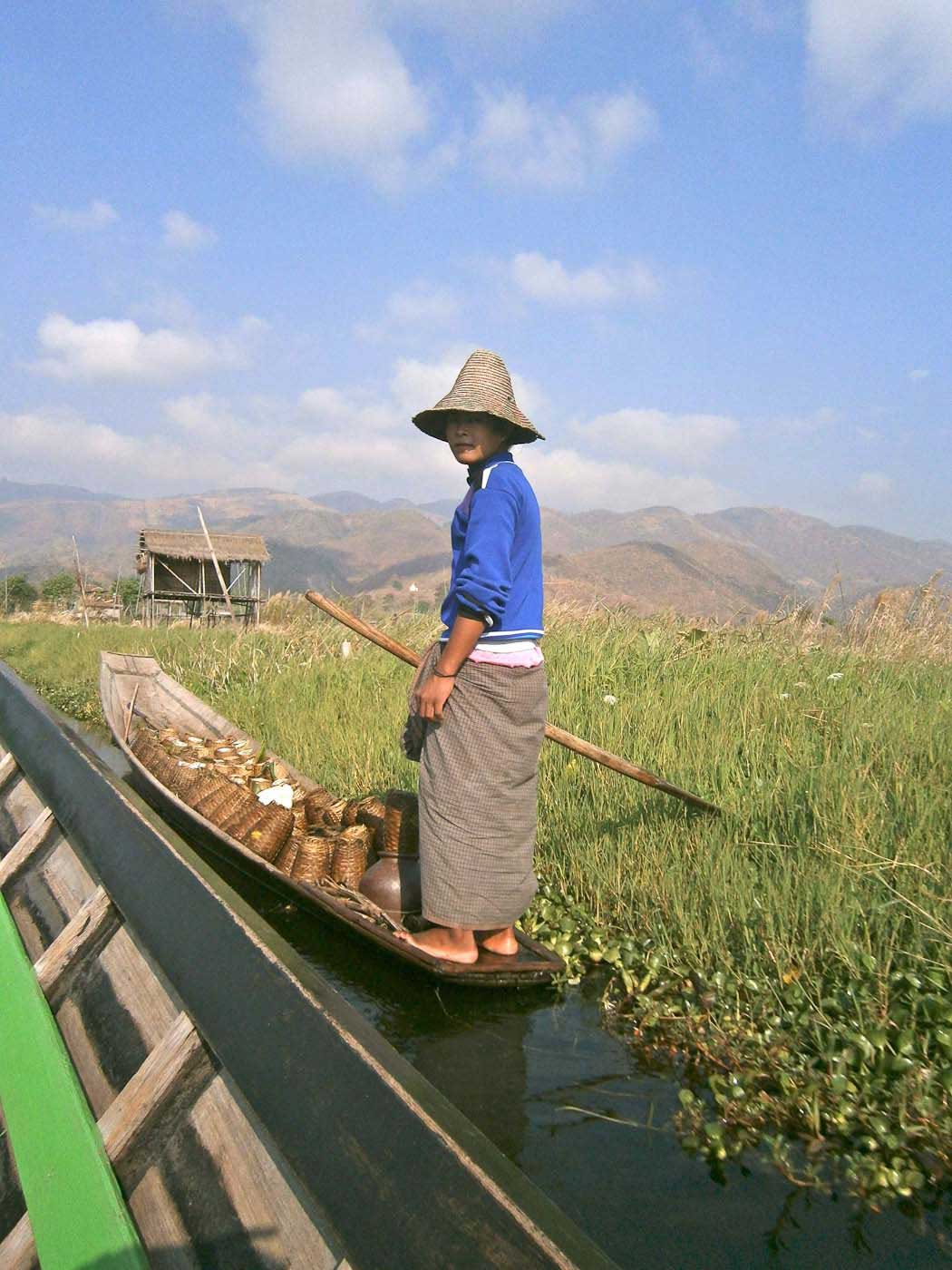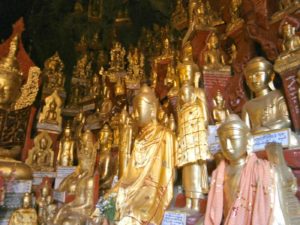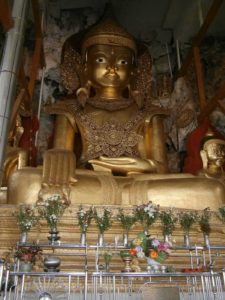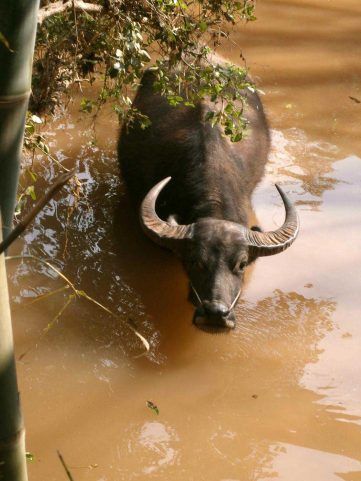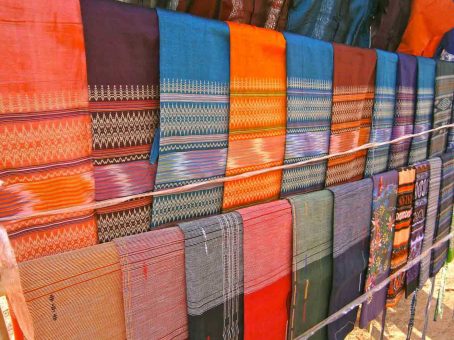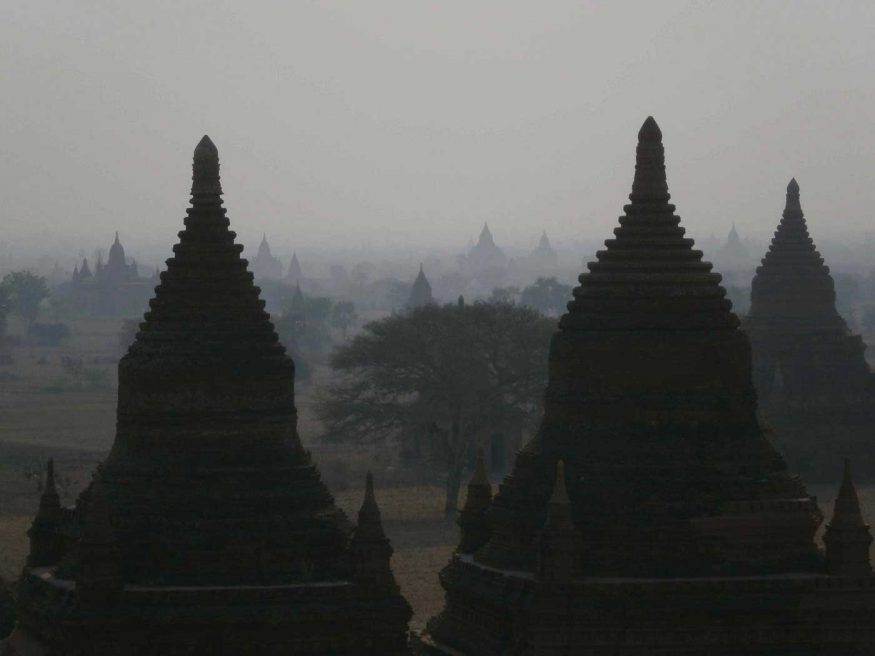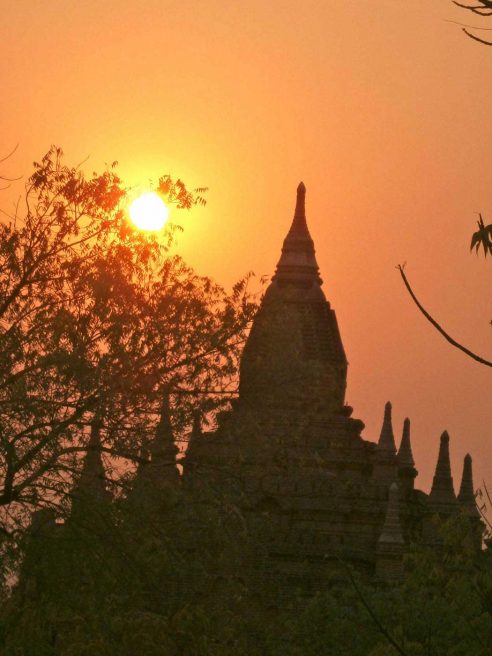Chasing tigers in the beautiful Corbett National Park
Ade was very excited about heading to India – not so much for the Ganges or the Taj Mahal but for the opportunity to see tigers.
So we had to set aside time to visit Corbett National Park, just near Ramnagar.
We arrived late in the afternoon after an overnight train from Delhi – it was quite an experience listening to the chai-wallah wander up and down the carriage calling ‘chai, chai, chai’, and selling bags of nuts and seeds. I must admit I was a little concerned when the train separated and one half went in one direction and the back end went in a different direction. Fortunately we were in the correct carriage, heading in the right direction.
As soon as we arrived in Ramnagar we arranged to do a night tour, which was quite fortunate, as it turns out that was the only time we saw a tiger. And even then, we can’t be sure it was actually a tiger.
The nighttime drive was just a bonus and while it was an exciting experience, it was very difficult to see any animals in the dark. It was also somewhat eerie being in the Indian jungle in an open air jeep at night looking for tigers.
The following day we were up early ready for a full day looking for tigers. We saw plenty of birds, elephants, monkeys and deer but no tigers. Despite the lack of tigers it was an enjoyable day in the park. While there we took a ride on an elephant – I can’t believe how high we were up there.
And while I had a lot of fun on it – though admittedly I was a bit nervous about what would happen if we did encounter any tigers – according to Adrian it’s not such a great way to travel if you want to take photos.
Back down on land, on four tyres, and we listened as the monkeys screeched warnings to each other that a tiger was nearby. Our excitement grew and we joined a cavalcade of vans queuing up to try and get a glimpse of the tiger. We had no luck.
When we returned to our hotel after the game drive we bumped into two Australian boys who were also out on safari that day and had been chased by a tiger.
Apparently they stopped to photograph a tiger in a watering hole and watched in wander as he started to walk along the road. The driver followed the tiger, which soon turned and chased the jeep the boys were travelling in. The driver tried to get away, crashing into a tree in the process.
The tiger soon lost interest in the van and ran into the long grass. Meanwhile the boys got away with some great photos and a fantastic story.
Unfortunately, the only evidence of tigers in the park that we saw were paw prints on the roadside.
Join us on Twitter, Facebook and Instagram for more travel inspiration.
Finding serenity on a charming old houseboat in Kashmir
The serene waters of Dal Lake are at great odds to our introduction to Kashmir.
We had originally wanted to go to Leh, but were talked in to visiting Srinigar instead by the travel agent we spoke with in Delhi.
We booked our trip and then I read the guidebook , it had one line on one page – “If you value your life, do not go.” So of course we went.
I began to get cold feet when we arrived at the airport in Delhi and after going through all the usual security checks – which were already far more than we were used to – we were shepherded into a separate room which we weren’t allowed to leave. We were all called outside to check our bags and then had to go through a second – or was it third? – security screening on the tarmac before getting on the plane.
But that was all mild compared to our landing in Srinigar. The airport in the Kashmir capital doubles as a military base and it felt somewhat like we were landing on the set of MASH (indeed when we were getting ready to depart the city our plane was delayed as we waited for fighter jets to take off).
The airport itself was only half finished, and what was there was half under camouflage mesh.
As we drove out to our houseboat – home for the next few days – I couldn’t help but notice the army officers stationed outside every second or third shop. They may have been police officers, but were all dressed in khaki and were carrying machine guns.
Things may have calmed down in Kashmir but the military presence was a constant reminder that trouble is never too far away.
It’s no wonder then that on my first night on the houseboat I lay shaking under the doona listening to what I was sure was gunshots all night. At one point Adrian woke up as the bed was vibrating so much and asked what was wrong. “We’re leaving tomorrow, first thing,” I said. “I can’t stay here, listen to those guns.”
The next morning Adrian asked what all the noise was during the night, we found out it was wedding season and what I was so sure was gunfire was actually fireworks.
After that first night, our experience on Dal Lake was completely tranquil.
We were the only guests on the boat and as such had the cook, who doubled as our guide, all to ourselves. We also had the living room, the balcony and the entire boat to ourselves. The houseboat didn’t actually move, it was stationary on the edge of Dal Lake, and our jetty onto the boat had definitely seen better days. But the houseboat itself was beautiful – timber panelled, antique furniture, it looked like something from a bygone era.
Our guide/cook/protector, Mohammed, took us on a cruise through the floating markets, pointing out the man-made veggie patches in the middle of the lake and explaining the different architecture to us. He took us on a walking tour through the city where we visited the clay makers, the markets and watched as thousands of dishes were prepared for a wedding.
Floating through the rivers was somewhat like traversing the canals of Venice – though the architecture was quite different!
Somewhere along the way we met the owner of the houseboat, who arranged a trip into the mountains for us, but first an outing with he and his granddaughter to the Botanical Gardens and dinner at his house with all his family.
It’s rather a surreal feeling watching an Indian wedding of two people you have never met in a house in India with a family you are meeting for the first time.
Join us on Twitter, Facebook and Instagram for more travel chatter.
Conquering the heights and tracks in the Himalayas in India
I’m lying in a cocoon of sleeping bags and blankets staring at the single bare light globe outside our room. I have no idea what the time is, but know it must be very early morning. I can’t turn out the light. There is no switch in the room in the gypsy hut we have called home for the past two nights.
This is the only light for the hut, which houses three generations of the one family – the parents, their three sons, daughter-in-law and grandchild.
We will be leaving early the next morning, but now I am left remembering every step of my climb from that day, convinced that I will struggle to walk when dawn actually breaks.
We are in the Indian Himalayas in a town called Naranag, about two hours’ drive from Srinigar in Kashmir. We are here with a cook, who has travelled with us from Srinigar.
The day started early, after a night in which there was no light switched on at any time. When we first arrived in the town our cook pointed to the highest of the peaks that surrounded us and said “tomorrow you climb that”. We laughed, sure that we had told our travel agent in Srinigar that we wanted to do “a bit of a hike” but weren’t very fit. We couldn’t possibly walk up the steep peak in front of us.
But this morning it was clear he wasn’t kidding. We set out with our guides – two of the gypsy sons from the house we are staying in. I couldn’t help but notice their shoes as we ambled up the side of the mountain. The black loafers they were wearing were barely held together and looked like something my grandfather might have once worn to church – not, I imagine, the most comfortable walking shoes, but my husband and I in our new and expensive Kathmandu hiking boots struggled to keep up with them as they hiked easily up the mountainside.
We were hiking from 10,000 feet to 13,000 feet over steep, rocky terrain – just us, our guides, and the horse we hired to help carry us part of the way. Ade and I took it in turns riding as we got tired, though the horse looked more exhausted than we were most of the time and our guides refused to let Ade ride on the steepest sections for fear the horse would collapse – it did indeed stumble, with me on its back as we were gingerly making our way up a steep gravel incline, picking our way between two large boulders. It was a surefire way to ensure I too wouldn’t ride him on the steepest sections of the mountain.
We climbed higher and higher until we could just see the town below, nestled into the base of the mountain. The views were breathtaking. From here we could see across the Himalayas to Gangabal Laken and a glacier, if we had another day we could hike across to the glacier, but alas, we just had the one day on this mountain so instead we sat and gazed across the peaks as we ate lunch. It was so peaceful in the mountains – seemingly a world away from the armies still stationed in Srinigar. We only saw two other people on the mountain – interestingly a couple also from Australia – bounding up the mountain with their guides.
We sat enjoying the 360 degree views and the serenity for an hour before we had to leave for the trek back down. Our horse had given up and one of our guides had taken him home already, so for the journey back, we were on our own.
The walk down was only marginally better than the journey up. We followed the steep winding track back to our hut and got back just in time for dinner – chicken soup followed by chicken curry.
After dinner the Gypsy family invited us into their living room for a cup of tea. We sat on the floor in front of the open fire place that doubled as the family’s stove. As well as being the family living and dining room, the room was the parent’s bedroom. A mudbrick ledge divided the sitting area from the sleeping areas. Our hosts were very nice, despite the language barrier they included us in their discussions – it didn’t work but we had a good laugh trying to understand each other and spent a very pleasant couple of hours passing time in front of the fire, drinking tea.
The following morning we are up early again, this time to wait for the car that will take us back to Srinigar. Surprisingly, we can both move – no aching joints. At least we feel ok until we start the hike up to the road – 500 metres straight up, it is nothing compared to the walk we completed the day before, yet I struggle to put one foot in front of the other.
We get to the road and as we wait for our car, dwarfed by the mountain we conquered just 24 hours earlier, we watch as young kids make their way to school and line up outside their classroom. For them, it is just another day but their small hamlet has made an impression that will not be forgotten anytime soon.
Note: Srinigar and Kashmir are not for the faint-hearted. The Australian Government website advises against travel to Kashmir, however for those who make the journey, it is very rewarding.
Join us on Facebook, Instagram and Twitter for more travel chatter.
The interesting sites of Gwalior and how not to arrive in India First stop the 'calm' of Gwalior
We arrive in Delhi at 4am and head straight for New Delhi train station – no local currency, no hotel booking and only a loose plan to head to Gwalior. The ‘bank’ at the airport is closed and we have no way to change any money – not a great start to our adventure.
We hire a tuk tuk, or was it a car? At that time in the morning who can really tell? And make our way to the station via an ATM. (We understand you may not want to take travel advice from us, but really life is all about adventure, right?)
Despite the early hour New Delhi station is packed and chaotic. And as the only westerners in sight and lugging huge backpacks, we are easy targets for the many touts trying to make a quick buck from the “rich” tourists. We are headed for Gwalior, a town of about a million inhabitants – by Indian standards, just a small town.
After much negotiation – “you have to get your tickets from the tourist window upstairs”, yes but that window is closed, “ok then you have to go across the road to that tourist office”. No, I think I’ll go straight to the ticket window thanks, and if they won’t sell me a ticket we’ll walk across the road to get them. They did sell us a ticket, of course. A first class ticket on the Shitabi Express – it definitely wasn’t the cheapest ticket, but it proved a relaxing way to travel after our chaotic arrival.
Gwalior is a good introduction to India, it is quieter than the more well-known tourist tracks and is easy to get around on foot or rickshaw.
The city centre is rather unremarkable, but it sits in the shadow of the impressive Gwalior Fort. Set over three kilometres, and at 90 metres above the city, the fort is an imposing protector of the streets below. It is an easy stroll around the large grounds and while there is much to see, Man Mandir’s Palace is the most impressive of the old buildings.
Legend has it that the fort was built by King Suraj in the first century AD and the site was named after a holy hermit, Gwalipa, who cured Suraj’s leprosy. The fort has been ruled by all the region’s succeeding dynasties.
Since 1886 it has belonged to Gwalior’s Royal Family, the Scindias.
Down in the city centre is Gwalior’s Jai Vilas Palace, built by Maharaja Jiyaji Rao Scindia in 1875. The Palace, which is still used by the royal family, is partially opened to the public. It boasts an impressive stateroom that houses two impressive Belgian chandeliers and a model train in the dining room that winds its way around the large dining table to deliver cigars and drinks to guests! You know your dining table is too large when you need a train to deliver drinks!
Join us on Twitter, Facebook and Instagram for more travel chatter.
Six things that make India awesome
India is renowned for its majestic monuments and the Taj Mahal, the most famous of them all, certainly lives up to its reputation. But there are many other delights just waiting to be discovered in this amazing country.
India has hundreds of forts dotted across the countryside. Jaipur alone has at least three forts. But each of the forts is unique and it’s worth spending time learning about the country’s history through its many forts. Just be ready to pose for photos for the locals. We had countless photos taken with local tourists who were intrigued by our white skin.
Many people go to India for the architecture. But every bit as impressive as the architectural marvels are the Indian Himalayas. India has some of the tallest mountains in the world. And while it may not quite live up to its title as the “Switzerland” of India, the mountains in Kashmir are nonetheless breathtaking.
When it comes to religion, India has most of them covered. Hindu, Muslim, Buddhism and Christian. While it is not completely free of trouble the different religions live in peace and harmony much of the time and provide a really interesting travel experience. The impact of religion is evident throughout the country and again it’s an interesting way to explore the country’s rich history.
But there is no where quite like Varanassi – the holiest place in India. Varanassi, and the Ganges in particular, is the final resting place for many Indians and while the locals make their pilgrimage to the holy waters, the tourists also come here in their thousands. Be sure to get up early to watch the sun rise over the Ganges, it is a truly magical experience.
India has some incredible national parks, and of course it’s one of the few countries in the world in which the Royal Bengal Tiger can be found in the wild. We were fortunate to spend three nights in Ramnagar, the main town from which to enter Corbett National Park. We were there in search of the elusive tiger, and while we weren’t lucky enough this time to spot a tiger, we did see many other wild animals and birdlife.
India, it has to be said, is a tough country to travel through but the rewards make it truly worth the effort. It may be a cliché, but it’s true what they say – India really does get under your skin.
Join us on Facebook, Instagram and Twitter for more travel chatter.
Taking in the beauty of Inle Lake And our final stop in Yangon
After the two day hike from Kalaw, we weren’t sure that we could walk the final steps to our boat for the final leg of our journey to the hotel in Inle Lake. But of course we did.
The walk out to the boat is beautiful – stilted homes on the river and floating garden beds. The boatride to the hotel took about an hour and a half – Inle Lake is much larger than I had anticipated.
But it has some of the most beautiful scenery we saw during our travels in Myanmar.
The following morning we met our boat driver at 8.30 ready for a full day on the lake. First stop was the market – though our guide had tried to talk us out of it, we insisted. The market was not as big as we had expected, but it was interesting to see all the foods on sale – and a little off-putting to think that the meat sits in that heat all day with flies all over it.
Our tour of the lake included a stop at the silversmiths, blacksmiths, cigar makers, floating village, the jumping cat monastery (unfortunately the cats hadn’t jumped for months) and a Pagoda consisting of five Buddhas. The Buddhas had so much gold leaf applied to them (by men only, women aren’t allowed to apply gold leaf in this Pagoda) they barely resembled Buddhas.
Our last stop was a local village near Mein Thauk, which consisted of a very long and very rickety bridge – it was in slightly better repair than U-Bein Bridge however, and had far fewer people walking across it.
Watching the local fishermen rowing their boats using their feet is also quite a spectacle so while there are many places to stop on the lake and so many things to see and do around it, the activity on the lake itself is just as interesting.
On our last day at Inle Lake we decided we had seen enough of the water and chose to hire bikes and ride out to some hot springs.
It wasn’t really the best weather for hot springs, considering the heat, nor for a bike ride for that matter, but the guidebook said it was a very pleasant ride and it was either that or another massage!
It was a lovely ride despite the hills and passing traffic and the springs were actually very refreshing and quite soothing, it even cooled down just in time for our ride back.
Our flight leaving He Ho was late so by the time we arrived at Yangon airport Anna had left. We didn’t have her home address so after some anxious moments trying to figure out her phone number we managed to work out where to send the taxi driver.
Our last day in Myanmar was spent sight seeing in Yangon. In the morning we went to a local village – the home of one of Anna’s friends. The village was about an hour away by boat and as we pulled up there were a whole lot of villagers dressed in all their finery crossing a footbridge. Anna’s friend explained that the young boys and girls of the village were entering the monastery and this was a procession in celebration.
Those entering the monastery can’t touch the ground after leaving their homes so they were carried on bikes, horseback or in their parents arms to the monastery where they would change into their robes and have their heads shaved. We visited our guide’s family, had some tea and spent the morning wandering around the village, seeing the dirty well where they got their water and visiting the monastery and school. Everywhere we went we were followed by local children who seemed excited to have visitors in their town – we were clearly a novelty.
In the afternoon we visited the Yangon market – it was huge and I’m sure we only saw a quarter of it, but it’s always good to save a little something for the next time you visit a place.
Let’s get social. Join @AllAbroadAU on Twitter, Instagram and Facebook for more travel chatter.
A gentle stroll from Kalaw and an amazing Buddha cave With a side trip to see 8000 Buddha images
Arriving in He Ho, we grabbed a taxi (tried to haggle the price but to no avail), and headed to Kalaw via Pindaya.
Pindaya looks like a lovely town, but we were here to see the caves, which house more than 8000 Buddha images. The caves are quite amazing and it’s bizarre to see so many gold statues tucked in a cave. Just beyond the main cave is a smaller cave housing a 40-foot Buddha, impressive in its own right, but then they light it up – it looks both amazing and a very kitsch.
The walk up to the caves is interesting in itself, but if you don’t feel like walking, you can take a lift up the side of the mountain – yep, you read that correctly! Switzerland may have their cable cars and funiculars, but Myanmar has gone one step further with an elevator.
From Pindaya we headed to Kalaw for an overnight stop. Our only view of the town was from the taxi as we drove through. We stayed at Amara Resort, a beautiful B and B in the mountains and while there was no pool, we did manage to squeeze in a massage.
The following morning we were up early and ready to begin our two-day trek to Inle Lake. The guidebook explained the trek as a cultural/agricultural trek so we expected an urban walk through many towns. In reality there were very few towns, and yet I still somehow managed to pick up a souvenir along the way.
At the first village we came to we stopped for tea and watched an old lady weaving a bag, I bought a hand-woven headscarf from her and delighted the children by having them wrap it around my head.
The village was very traditional, bamboo huts, solar powered energy and pump water, yet when we stopped for tea, they wanted nothing for it; they saw us as their guests. So we paid a little extra for the headscarf to show our appreciation.
The next stop was in someone’s home for lunch. By this time we were absolutely exhausted from the morning’s walk, so we lay on the floor for about an hour while our cook made our lunch. The food was beautiful, and despite being hungry we struggled to eat even a third of the food he had laid out for us. We tried to eat as much as we could as we knew he would be offended, but I’m sure he thought he was cooking for six people, not two.
We walked and walked across the countryside, our guide Koyji pointed out the sights along the way and explained the local way of life to us. Koyji was one of the gentlest souls I have ever met. Just being around him made us feel instantly calm.
We arrived at our final stop for the day, another traditional village, but this one was slightly larger than those we had stopped at earlier. Our cook had gone on ahead by motorbike after lunch to find us accommodation at one of the villager’s homes.
When we arrived at the village we headed straight for the shop for a coke and most importantly to rest our weary legs, while Kojyi went to find the cook. We waited and waited and just when we thought we would be spending the night on the seats in the café, they returned to take us to our home for the night.
Home was a brick and timber house with an outside toilet, no bathroom and an empty room for cooking. We were to sleep in the living room, which housed a Buddha shrine, a sewing machine, a table and a cupboard, no chairs. They had made us a cosy bed of blankets and pillows on the floor.
While our cook made us dinner, we explored the local village, chatting with the children and photographing every day life for a person living in Myanmar.
We ate dinner by candlelight on our balcony – the only chairs in the place, and sat with the male owner of the house. He was in his 70s and had been a monk until his 40s when he met his wife. She was a bit younger, now in her 50s and still had a beautiful smile that lit up her face. When they met, he fell in love and gave up the monastery. They had one daughter who was about 17 years old.
The owners didn’t speak any English, but we were able to work out that he had bad eyes. It was an interesting night’s sleep; Sam spent ages with the torch looking for spiders. And then of course we had to go outside with our torch in the middle of the night to go to the bathroom.
It was quite an unusual experience staying in this couple’s home. We barely saw them and I couldn’t help but feel very humbled that this couple freely opened up their home to us – complete strangers.
We gave them a donation to thank them for letting us stay in their home and the woman blessed us before we were on our way for our second day of walking. Considering how far we had walked the day before, I was surprised we could move, but we managed to continue on.
Kojyi assured us that the second day was easier than the first, but it certainly didn’t feel that way. If anything it felt harder. We had a short break at a roadside shop along with all the other crazy tourists undertaking this trek, and then walked and walked, through valleys and mountains, across the Myanmar countryside. By car the trip would have taken about two hours, it took us one and a half days to walk it, but it was an amazing experience.
Let’s get social. Join @AllAbroadAU on Twitter, Instagram and Facebook for more travel chatter.
The magic of Bagan And that iconic image
After spending the morning at Mt Popa we made our way to Bagan, home to more than 3000 temples and the iconic image of Myanmar.
We arrived early afternoon, just in time for a swim in the stunning hotel swimming pool, before we were on the road to get up close to some of the temples.
We got our driver to pick out the best of the temples for us to visit – we were never going to make it through all 3000 temples, so instead had to just take in a selection of the best.
We visited a range of different styled temples, all impressive. And of course the trinket sellers knew they were on to a good thing with us as they sold us bowls, t-shirts, pictures, tooth pick holders (because really, who doesn’t need a paper mache toothpick holder?) and jewellery boxes.
We spent the evening watching the sun set over the temples.
The touristy thing to do is climb one of the temples and watch as the sun drops over the thousands of surrounding temples – very stunning, very romantic and very crowded!
We asked our driver drop us off in old Bagan for dinner so we could check out the old town by night. We had thought we would walk back to our hotel, but it was quite dark by the time we finished dinner – no streetlights – and it only cost $5 to take a horse and cart, which looked far more fun!
So we jumped in for a bumpy ride back to the hotel – so bumpy that the skirt I had just bought that day fell out the back and we had to pull over while I ran back 50 metres to pick it up. Sam nearly fell out of the cart laughing.
Of all the temples in Bagan, the most important and apparently most impressive is the Amanda Pahto. And it certainly was impressive.
The temple consists of four large Buddhas and thousands of smaller Buddhas in the walls surrounding. There are three corridors around the central four Buddhas, apparently the inner corridor was for the King and Monk, the middle corridor for the Royal family and the outer corridor was for other worshippers. The walls between the corridors are about two metres thick.
The temple is believed to have been built around 1100AD. Apparently many of the temples here were Indian inspired, which could go some way toward explaining why the temples made me think of Khujaraoh.
After another day of temple viewing we asked to go to a school so our guide took us to an orphanage which was home to 71 children – novice Monks who have no relatives.
The students sleep on blankets on a wooden floor, all in one room and unlike most of the children we have seen here, none of them looked very happy.
We left a donation and then discovered they receive quite a lot of donations here, though it really didn’t look like they did, but then it must cost quite a bit to feed and clothe 71 boys.
Join us on Instagram, Facebook and Twitter for more travel chatter.
Fighting the monkeys at Mt Popa
It’s a four hour drive from Mandalay to Mt Popa and our only stops were for a drink at a roadside stall in one of the local villages and a stop for lunch at the bottom of Mt Popa before heading up to our hotel.
The lunch stop was the usual touristy fare – we sat inside an air-conditioned dining room, while the drivers sat in a separate area.
Of course we also had a sneaky stop to get our first glimpse of Mt Popa. We weren’t really sure what to expect, we knew we were here to walk up it and that there was a temple at the top, so this gave us our first real view of the mountain and temple.
Mt Popa is an extinct volcano, but it looks like a giant rock jutting out of the ground. An elaborate series of temples covers the top of the mountain and there is a covered stairway that takes visitors all the way to the top.
Our hotel was on a different mountain and had views directly across to the temples of Mt Popa. The resort was beautiful, I don’t think we saw another person while we there, and our hut was the last in a row of huts, so it was a little distance to the pool and restaurant, but we had spectacular views from our balcony across the valley to Mt Popa. It took us a while to pull ourselves away from the views and the comfort of our balcony, but a massage and swim beckoned before watching the sunset over the temple.
The following morning our driver arrived at 8.30am ready to take us to the base of Mt Popa. There is a cute little village at the base, making the most of the tourist trade no doubt.
The Mountain itself is full of monkeys, which were cute to begin with, but which soon snarled at Sam for taking photos and tried to jump on my back in attack. We soon learned to steer a wide path around them!
It’s about 700 steps up Mt Popa, again through trinket stalls, past a large number of temples and past men and women who clean the monkey poo off the steps. There are ‘cleaners’ at every turn on the steps and each one asks for a donation, we gave to the first, but soon realised we couldn’t give to them all (and I’m sure there were a couple who weren’t quite as dedicated to cleaning the steps as their colleagues!).
The top of Mt Popa consists of a labyrinth of temples and while it’s really interesting, it looks far more impressive looking up at it from the street, or across at it from our hotel balcony.
We had been negotiating getting a guide for Mt Popa before arriving in Myanmar, but in the end decided to just turn up and organise a guide once we were there. This was a mistake; there are no guides at the temple and no explanation boards, so I’m sure there was a lot we missed.
Join us on Instagram, Facebook and Twitter for more travel chatter.
Biggest books, oldest bridge: The road to Mandalay Myanmar's true culture on display
We had read much about the former capital of Myanmar, none of which was very positive. Nevertheless I was keen to see the city that had once generated so much interest.
It was definitely worth the effort. The city itself is chaotic, it doesn’t really seem like a city as such, more like a town.
But they do say you will see the true Myanmar culture here and I feel like it definitely was a richer cultural experience than Yangon.
We arrived early and headed straight to our hotel – the Hotel on the Red Canal. The hotel was a beautiful oasis in the hot, dusty city. But the Red Canal was really not worth a mention – it was more like a drain in the middle of the road!
Still the hot towels and juice on arrival soon made us overlook the canal. And despite the fact we arrived before 10am, they checked us in, apologised for not having our room ready and gave us a free coffee – unfortunately neither of us drink coffee but it was such a nice gesture I didn’t have the heart not to drink it.
Our room was beautiful, very relaxing. But we weren’t there to stay in the room; the sites of Mandalay were waiting. We wandered over to Mandalay Fort and Palace with the intention of hailing a taxi. The Fort is massive, the walls stretch on seemingly forever (in reality about two kilometres on each side) and are reflected in the surrounding moat.
 We hadn’t planned to, but when we got there we couldn’t resist looking around the Fort and I’m glad we took the time. Much of the fort grounds are used by the military and are out of bounds to tourists, but they have rebuilt parts of the old palace and surrounding houses.
We hadn’t planned to, but when we got there we couldn’t resist looking around the Fort and I’m glad we took the time. Much of the fort grounds are used by the military and are out of bounds to tourists, but they have rebuilt parts of the old palace and surrounding houses.
The Palace dates back to 1857 and was apparently the Royal Palace of the last Burmese Monarchy. The buildings are all crafted in teak and each of the homes mirror the next. All are empty, so really there is no need to walk through every one – tempting though it may be! It’s worth climbing up the lookout for a view out over the grounds and palace, but the narrow and rickety staircase may not appeal to those that don’t like heights (Sam found the going tough on the way up, and was almost just as nervous heading down!).
We thought it would be easier to flag down a taxi from here, and while we managed to do so, it wasn’t quite as easy as we had thought. But after 20 minutes of negotiating with a local drink cart owner, a taxi driver had arrived and we had agreed a price for a trip to U Bein Bridge and Sagaing Hill – $20 for the afternoon.
Our driver spoke more than passable English, and was more tour guide than taxi driver, so while we had asked to be taken to the two sites, we got so much more.
Our first stop was the gold pounding district in the heart of Mandalay, where we watched well-built men pound and pound gold, turning it from gold pieces into gold leaf. The gold leaf is sold in packets at Buddha sites all around the country – apparently if you put the leaf onto an area of Buddha’s body that is troubling you, it will be fixed.
From here we went on to Mahamuni Paya to see the seated Buddha. The temple was amazing, and the Buddha was very impressive – it was covered with layers and layers of gold. Unfortunately only men are allowed to put the gold leaf on this particular statue, a little odd as both Sam and I had done this at the Shwedagon so I’m not sure why women weren’t allowed to do so here.
Our next stop was the marble polishing district and an iron-casting place. All of which were very interesting, but we really wanted to get to the temples at Sagaing.
The drive out was beautiful, along something of a ‘lover’s lane’ with loveseats dotted along the roadside, all of them occupied by couples enjoying the scenery.
Sagaing Hill was breathtaking – pagodas dotted through the mountainside. Our driver knew when to stop for us to take photos, took us to the Buddhist Monk University then a primary school where we met children who would grow up to become monks and nuns.
The children were so happy and delighted in having their photos taken. But they were crowded into classrooms and some of them were falling asleep as the teacher tried to teach them.
It was also somewhat of a surprise to see all the children – girls and boys – with their heads shaved. Many of the children in the school are orphans and others came from very poor families. The driver told us the children would not eat dinner and would not eat until 5am the following morning; they must have been starving (although sometimes the teachers would sneak food to the youngest children). We left a donation and headed up to Sun U Ponya Shin Paya, built in 1312. Sun U Ponya Shin Paya is one of the most important shrines at Sagaing Hill. The shrine is covered in glass tiles giving it an interesting shimmer.
The hillside is covered in seemingly hundreds of pagodas and temples, most of which are topped with gold leaf spires. With more time you could walk the path that criss-crosses the hill, taking you past the major shrines. Alas, we were on a tight schedule so almost had to run through the Sun U Ponya Shin Paya to ensure we saw it all, before moving on.
Our driver was insistent that we needed to get to U Bein Bridge for sunset. The bridge is 1.2km long; it crosses Taungthaman Lake and is very rickety! It was built from teakwood in 1850 and is believed to be the oldest, longest teakwood bridge in the world. Evidently the tourist thing to do is take a boat out and watch the sunset, then walk back across the bridge. Our boat driver was a kid in grade six at school, but he was excellent and chatted to us along the way.
We got off the boat, which is actually kind of like a gondola, half way along the bridge and walked back. The bridge is a footbridge and looks like it may fall down any minute. Hundreds of tourists were crossing the bridge, which made me wonder how much longer the bridge could withstand that much traffic. But the experience is quite magical.
By the time we got back to our hotel at 7pm we were exhausted – hot , sweaty and tired. But waiting at the entrance of the hotel were staff members with cold wet face washers – a very welcome return. It’s just a shame we missed cocktail hour!
We had arranged for the taxi driver to pick us up again the next morning to take us to the docks in time to catch a boat to Mingon. We made it with time to spare so we chatted to the locals. We took the slow boat to Mingon, which is famous for the partial building of a giant pagoda. In truth only the base was finished and even this has since been damaged in earthquakes, but it is a lovely place to visit for the morning. If it had been finished, the pagoda would have been the largest in the world. Unfortunately the king died before it was finished and so it remains incomplete.
As the boat full of tourists pulled up, the ‘taxi drivers’ lined the riverbank trying to attract attention. The taxis were actually carts pulled by cows. Of course Sam and I picked ours out straight away. We got off the boat and were immediately accosted by girls selling hats, jewellery, umbrellas… We were a soft target and had to force ourselves to move on to ensure we actually saw some of the sights of Mingon and didn’t just spend all our time shopping.
Somehow, in trying to negotiate the taxi and the shopping we had ended up with a young tour guide, we thought he came with the taxi, but evidently not. He spoke excellent English and knew a lot about the area. We ended up paying him far too much, but he was very good and very funny.
The town is also known for its large bell – the second largest in the world and the largest non-cracked hanging bell. We stood inside it while our guide rang it – fortunately it wasn’t as loud as we had expected it to be, and then went to see the temple built for the Queen.
The Queen’s Temple looks like a maze from a distance. Sometime way back when the temple had been raided and the perpetrators had pulled the head off the original Buddha looking for gold (it’s actually buried underground according to our guide). They tried to put the head back on, but it was too low, so they put another Buddha in front instead. The two Buddhas still sit there, one behind the other.
After a quick swim back at the hotel in our gorgeous swimming pool, our driver picked us up at 4 to take us up to Mandalay Hill where there are meant to be stunning sunsets over Mandalay. But our driver suggested that instead of watching the sunset, we could go to a Monastery to listen to the Monks chanting. Of course, we decided to do both!
On our way we took a quick detour to the World’s Biggest Book, 729 pages inscribed into marble, each housed in its own temple. The book tells of the enlightenment.
We didn’t have time to walk up all the steps leading up Mandalay Hill so our driver dropped us off near the top. Once again we passed a range of trinket stalls all along the steps. The top of Mandalay Hill is a series of temples and a labyrinth of marble, stone and glass. Just as we thought we were at the top, we would see yet another staircase and another arrow leading us ever higher. We thought we were at the top when we reached a large tin shed with yet another temple inside and really, we couldn’t see what all the fuss was about. But then we kept walking, past more stalls and up more steps.
Once you actually reach the top, it is quite remarkable; a kind of glass and mirror temple. Unfortunately the air was very hazy so the sunset wasn’t particularly good for the hundreds of tourists crowding the temple to watch. We had a very quick look around and then ran down to try and get to the monastery in time to see the monks. The Monastery was beautiful and I had expected there to be hundreds of tourists here also, but there was only one other couple with a guide. We watched as the Monks walked out in line, chanting all the way – the little one at the back couldn’t quite get his robes sorted so was busy trying to tidy himself up the whole time!
While they filed into the temple to pray we toured the stunning library before sneaking a quick look at the Monks praying through the open windows of the temple.
Mandalay certainly hadn’t disappointed us.
Join us on Instagram, Facebook and Twitter for more travel chatter.
